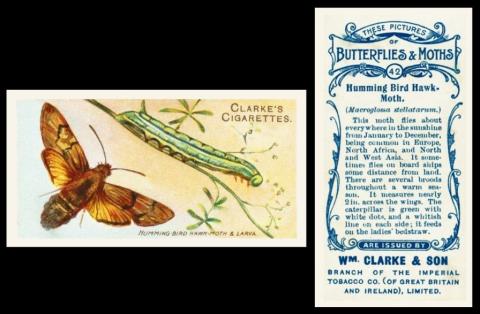
Now here in the United Kingdom, we do not have humming birds - nor in Europe, for that matter, though who knows what will happen as our climate continues to change.
What we do have though is this, the humming bird hawk moth. This arrives from Southern Europe every year about April, and it is quite unmistakable. Indeed, if you listen closely, you can hear that its wings move so fast that they, too, make a humming noise. However, it is a moth, and not a bird.
And it leaves us, for Europe, all over again, at the closing of the year.
This card is described in our original World Tobacco Issues Index as :
BUTTERFLIES & MOTHS. Sm. Nd. (50). See H.80. ... C90-12
Crucially, though, it is part of the sets which are listed as "with I.T.C. Clause", being issued under their partnership with the Imperial Tobacco Company. That, plus the handbook code, means there are other issuers, namely Adkin (issued in 1924 - and which appears in our newsletter for the 3rd of September 2022, on Friday the 9th of September) and John Player, which was issued first of all, in December 1904, but which we have yet to use. Whilst their entries in the World Tobacco Issues Index are identical to the one for Clarke, typed above, apart from the card code, both of them have reference books all their own, with more detailed information. You can read the Adkin write up by clicking the link above. One day I will use the Players too, and link to it from here.
As far as prices, or at least prices in the London Cigarette Card Catalogue for 1955, the Adkin`s version retailed at 4d a card or 20/- for a set - the Clarke`s version at between 4/- and 12/6 a card or £30 a set - and the John Player`s at between 2/- and 5/- a card or £12 a set.
You will also find a humming bird hawk moth in Gallaher`s "Butterflies and Moths" (1938) as card 41/48, but, curiously it is titled "Humming Bird Hawk" on front and back. The text on the reverse of that card reads : "This interesting moth is not very common in Britain, and most specimens are immigrants, though many appear to have hibernated here. Like the Humming Bird, it hovers in front of a flower, pushing its long tongue into the blossom. The caterpillar feeds chiefly on Bedstraw, and pupates inside a loosely woven cocoon. The moth, which has small wings for the size of its body, is one of the few which fly by day and are fond of the sunshine."
As for a trade card representation, how about the Green Humming-Bird Hawk Moth, as seen on card 19/25 of "Butterflies and Moths" by Swettenhams (issued in 1958), plus several other issuers, as detailed in our handbook under HX-2. (A.1 Dairies - 1966 / Badshah Tea - 1967 / Barratt & Co. - 1960 / Lamberts Tea - 1966 / Universal Cigarette Card Co. - no idea of date) The reverse text on these, but perhaps not the Universal Cigarette Card Co. version, reads : "GREEN HUMMING-BIRD HAWKMOTH (Pterogon Proserpina) This moth is common in Southern Europe and expands 1 1/4 to 1 1/2 inches. The young larva is pale green with no anal spot and resembles the larva of a butterfly. It also feeds on different species of Epilobium".
